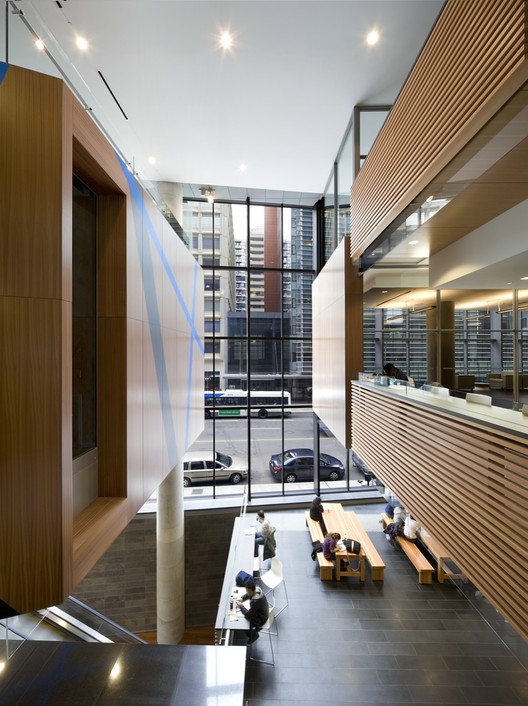
- Area: 375000 ft²
- Year: 2009
-
Photographs:Tom Arban , Eduard Hueber, Marc Cramer
Text description provided by the architects. The John Molson School of Business (JMSB) was designed to accommodate faculty, administrators, and undergraduate and graduate students under one roof to foster a community of scholars and the exchange of ideas. It is also the outcome of a winning design competition scheme. The JMSB represents the third building to complete the bold vision to create Le Quartier Concordia - a new vertical campus bringing together Visual Arts, Engineering/Computer Science and Business on two blocks in downtown Montreal to raise the profile of Concordia’s brand.

The design leverages Montreal’s urban and natural geography to inject vibrancy into an underutilized precinct. The JMSB occupies a section of St. Catherine Street, a primary retail arterial, in downtown Montreal. The 17-story building is oriented to capture views of the city’s main natural features, the St. Lawrence River and Mont Royal. The interior topography of stacked atria with interconnecting stairs, lounges and a variety of teaching and gathering spaces, was planned and designed to optimize face-to-face interaction between the students and faculty of JMSB. The concrete loft structure is inherently flexible to facilitate connectivity and change, and the emphasis on quality in materials and detailing further advances goals for long term value.

Described as a ‘green centre,’ in addition to meeting LEED Silver requirements, the JMSB features one of the world’s first combinations of solar heat and power technology integrated into a non-residential building as well as the largest solar-electric installation in Quebec.

Facilitating Outstanding Teaching and Discussion-Based Learning
To provide innovation, flexibility and cutting edge technology in classroom and seminar room design, KPMB and user representatives from JMSB conducted an extensive tour of the top business schools in North America to study classroom typologies and develop templates for JMSB teaching spaces. Unlike Harvard, which is committed to the case study format, JMSB determined it would have a variety of formats in a 60 student per class module to accommodate the diversity of teaching modes to distinguish JMSB’s unique brand of openness and inclusivity. The project also includes the ‘breakout’ or ‘teaching in the round classroom.’ The total of 45 classrooms are each individually equipped with complete AV systems: Crestron control panels, flip-top cable storage compartments, computers, DVD and VHS players, LCD projectors, projection screens, speakers and motion sensor controlled highlighting.

Vibrancy and Cross-disciplinary Exchange
Opportunities for breakout, both formal closed configurations and open casual configurations, are designed and located to intensify a sense of community within the tower format, with an emphasis on creating a hub of activity on the first four floors. The second floor features a ‘floating event room’ suspended in the main atrium, and closed group study areas on the second and third floors provide options for various scales of gathering. The top of the Special Functions room is used as a student lounge and workspace area. Roof terraces are designed as outdoor extensions of offices, study areas and lounge space. The 15th floor has a faculty lounge with terrace and an oval conference room with catering facilities.

Environmental Sustainability
The design was conceived at the threshold of sustainable design and energy reduction emerging as priorities in architecture. At the same time, the Faculty of Business and Administration was also expanding its focus on sustainable issues, and has since established the David O’Brien Centre for Sustainable Enterprise to position Concordia as a leader in business practices that support corporate and social responsibility, and environmental initiatives. Designed as a forerunner to LEED, Concordia, the Faculty and the architects committed early on to establishing the JMSB as a ‘green’ centre. The design meets LEED Silver level requirements.

The John Molson School of Business is also distinguished as the world’s first demonstration of an innovative combination of solar heat and power technology integrated into a non-residential building as well as the largest solar-electric installation in Quebec. It features approximately 300 sq. metres of an innovative photovoltaic-thermal system. It represents the next generation of building design in that it will not only produce energy for its own use, but produce energy for the electricity network. A large energy display in the lobby will allow the public to view the real-time energy captured by the sun and used by the building. Strategic decisions, such as the absence of indoor parking and the integration of an underground tunnel to the Guy Metro station, encourage access by public transit.


























